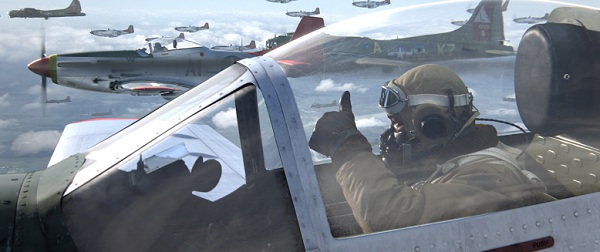A film, long, long overdue, in a decade not so far away
Swift shot: Despite a tacky soundtrack and a high-school AV club font for the credits which looked like it was ripped right from Windows Paint, this film delivered some solid memories. Thanks to the previews, I was expecting it to have modern music for the sound, ala “A Knight’s Tale” and “Marie Antoinette”, but they went with a more traditional score. I wish they had opted for the modern style, because the music never worked for me . . . granted I was focused on it the whole time. I was also expecting a lot from the folks at Lucas’ Industrial Lights & Magic (ILM), and they didn’t let me down. The gritty attention to detail paid to the P40 Warhawks with rusty bolts and hinges in contrast to sexy, mint P51 Mustangs was noteworthy. The actors were a bit rough around the edges, but as the film progressed, I found myself more drawn to the characters and less focused on the film’s elements.
Set in 1944, Italy, we follow the “historical” adventures of the 332nd Fighter Group, comprised entirely of “negro” pilots and crewmen. In 1944, the brass has decided to grant black soldiers the chance to prove they can stand toe-to-toe with any other Americans in the war effort. One bold initiative creates the 332nd and, at least on paper, affords the men that chance. Met with nothing but resistance along their path to become pilots, the men form a strong bond – probably more significant than most other soldiers who essentially take for granted that they have at least earned a grudging respect from their comrades. Not so for the 332nd, everything they are doing is literally being scrutinized by everyone in the world, not just the military, and not just the Americans. They are under a lot of pressure to be beyond good . . . thing is, the brass isn’t exactly giving them any real missions worth a damn.
And that is where we come in, after a routine mission of “killing traffic” (one of my favorite lines) their Colonel, Bullard (Terrence Howard) is called to Washington D.C. following some harsh words from the press that the negro pilot experiment is a failure. One particularly nasty Colonel, Mortamus (Bryan “Breaking Bad” Cranston) has leaked the false story in the hopes of putting an end to them once and for all. Now the pressure is higher than ever for them to show they can take on dangerous missions, and they are granted an air cover mission for an Allied Landing . . . Operation Shingle. Not only do they accomplish their mission, they log some significant kills. Speaking of killing . . . this film is incredibly violent, lots of strafing runs, lots of explosions and people meeting their mortal end. For the most part these people were Nazis, so no one really minded, but in all wars even the good guys die, and Red Tails does show a few of the good guys eating dirt too. In fact, with four words, the entire tone of the film shifts in one dramatic dogfight.
I read on imdb that George Lucas started this project in 1988 and couldn’t get any significant funding, because “an all black cast isn’t going to sell tickets”. Interestingly, he foot most of the bill for this film himself, and stylized the leads after historical figures from black civil rights lore, Easy, or Capt Marty Julian (Nate Parker) was inspired on Martin Luther King, Jr. Lightning, or Capt Joe Little (David Oyelowo) was inspired on Malcolm X, and considering the screenplay was co-written by the controversial “Boondocks” writer Aaron McGruder, it makes perfect sense. His characters are always bigger than life and inspired on great men and women.
The other characters make up a fairly motley crew of pilots and mechanics which reminded me a lot of the Black Sheep Squadron that I used to watch with my dad, with clever call-signs and a bit of arrogance and flair. There really were too many to list here, but my favorite supporting actor would have to be Ne-Yo as Smokey who delivers the most clever line of the film.
I wanted to like this one a little bit more, and it is a freakin’ crying shame that in 2012 no one stepped up to the plate and assisted George Lucas to the point where this film was on an epic scale, I wasn’t overly impressed with Terrence Blanchard when I am spoiled with John Williams doing Lucas’ other scores and some other elements felt tacked on at the end as well. In once scene, Lightning takes on an entire Officer’s Club filled with white pilots, and he is in the stockade the next scene without a scratch on him, not so much as a hangnail. That might fly in an amateur’s reel, but not when I see Lucas’ name attached. Ultimately, this film was not all that it could, and should, have been. The aerial combat sequences were tight and magnificent, and I really have not one bad thing to say about them. The story was interesting, but I felt that a lot of the film was rushed in order to get as much “history” into the final edits and I think some things should have been cut out altogether.
As far as the historical accuracy of this film, I will let you do your own research. But in my research it was interesting to see that even as late as this decade, controversy over the historical accuracy of the documented combat missions still hasn’t been soundly put to rest. Perhaps this film will serve to do what it was ultimately intended to do, get Americans, black, white, red, yellow, blue, purple, green, who cares, to care about the sacrifices of these ‘colored’ men who not only had to fight a war, they had to fight to earn even a modicum of respect in their “free” country. We all have battles, and we have all had to deal with prejudices, but I challenge anyone to say these aviators weren’t some of the most mentally tough men to ever wear wings. The Red Tailed Angels of the sky.




